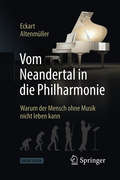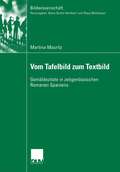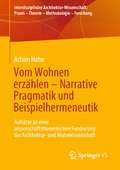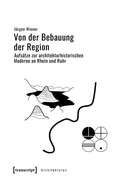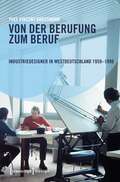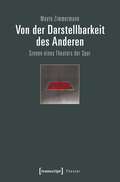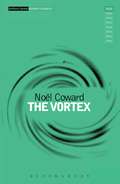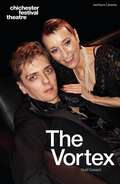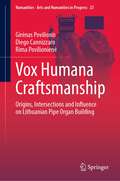- Table View
- List View
Volume Graphics 2001: Proceedings of the Joint IEEE TCVG and Eurographics Workshop in Stony Brook, New York, USA, June 21–22, 2001 (Eurographics)
by K. Mueller A. KaufmanThis book contains the proceedings of the International Workshop on Volume Graphics 200 1 (VG'O I) which took place on June 21 and June 22 at Stony Brook, New York. This year's event was the second in the series, following a successful premiere in Swansea, Wales, in March 1999, and was co-sponsored by the IEEE Technical Committee on Visualization and Graphics (TC-VG) as well as EUROGRAPHICS. The Volume Graphics Workshop is held bi-annually and has been created to pro vide a forum for the exploration and advancement of volume-based techniques, beyond the scope of just volume visualization. It brings together researchers and practitioners both from academia and industry, from many parts of the world. Volume graphics is in the process of evolving into a general graphics technology, and the papers included in these proceedings are testimonial to the wide spectrum of unique applications and solu tions that volumetric representations are able to offer.
Vom Ethos in Nachhaltigkeitsberichten: Wie wird Glaubwürdigkeit visuell dargestellt? Eine designrhetorische Analyse (Design #43)
by Sophie HeinsGlaubwürdigkeit und Vertrauen sind zentrale Ziele der Kommunikation von Corporate Social Responsibility - der gesellschaftlichen Verantwortungsübernahme von Unternehmen. Nachhaltigkeitsberichte gelten dabei als das wichtigste persuasive Kommunikationsmedium, wobei die Rolle der visuellen Argumentation hierbei noch wenig erforscht ist. Sophie Heins geht in ihrer umfassenden designrhetorischen Studie der Frage nach, mit welchen visuell-rhetorischen Mitteln Glaubwürdigkeit in Nachhaltigkeitsberichten erzeugt wird. Dazu analysiert sie die Wirkungen der Designelemente sowie ihr Zusammenspiel, und stellt visuelle Argumentationsarten vor, die eine neue Sicht auf Nachhaltigkeitsberichte ermöglichen.
Vom Neandertal in die Philharmonie: Warum der Mensch ohne Musik nicht leben kann
by Eckart AltenmüllerWarum haben wir Menschen Musik? Wie entfaltet Musik ihre Wirkung? Was geht dabei in unserem Gehirn vor? Fördert Musik die Intelligenz? Dient sie dem Gruppenzusammenhalt? Teilt Musik Emotionen mit? Dieses Buch erklärt die zahlreichen Wirkungen von Musik auf Fühlen und Denken, auf die Organisation von Gruppen sowie auf unsere körperliche und geistige Gesundheit. Im ersten Teil des Werkes werden die evolutionären Grundlagen der Musikwahrnehmung und des Musizierens dargestellt. Die faszinierenden neuen Erkenntnisse zu den positiven, aber auch den negativen Auswirkungen intensiven Musizierens auf das Nervensystem werden in den folgenden Kapiteln geschildert. Glücklicherweise macht Musik nur selten krank – viel wichtiger sind die bislang noch gar nicht ausgeschöpften heilenden Potenziale und die große Macht der positiven Emotionen, die durch Musik ausgelöst werden. Mit diesen erfreulichen und zukunftsweisenden Aspekten schließt das Buch, das jeden ansprechen wird, der eine Liebe zur Musik empfindet, sei es als Musizierender oder als Hörer.
Vom Ornament zum Nationalkunstwerk: Zur Kunst- und Architekturtheorie Camillo Sittes
by Michael MönningerDer Wiener Architekt und Gewerbelehrer Camillo Sitte ist als Autor eines der wichtigsten Städtebau-Lehrbücher des 19. Jahrhunderts bekannt. Doch völlig in Vergessenheit geraten sind seine lebenslangen Forschungen über Malerei, Musik, Bühnenbild, Handwerk, Volkskunst, Gewerbe, Physiologie und Geschichte. Die Studie entdeckt in Sitte einen großen Kunstschriftsteller des Fin de Siècle wieder. Vor allem wegen seiner Orientierung am Entwicklungsdenken der Evolutionsbiologie ist er ein Ahne des avanciertesten Naturdenkens in der heutigen Architektur- und Kunsttheorie.
Vom Tafelbild zum Textbild: Gemäldezitate in zeitgenössischen Romanen Spaniens (Bildwissenschaft #13)
by Martina MauritzIm Gemäldezitat verbinden sich Literatur und Malerei auf besonders intensive Weise. Martina Mauritz zeigt, dass das Gemäldezitat die jeweilige Thematik in den Romanen vielfach spiegelt und die Leser subtile und treffende Neuinterpretationen vieldiskutierter und nie zufriedenstellend gedeuteter Bildkunstwerke entdecken, die sowohl die Malerei in ein neues Licht rücken als auch die Betrachter.
Vom Wohnen erzählen – Narrative Pragmatik und Beispielhermeneutik: Aufsätze zu einer wissenschaftstheoretischen Fundierung der Architektur- und Wohnwissenschaft (Interdisziplinäre Architektur-Wissenschaft: Praxis – Theorie – Methodologie – Forschung)
by Achim HahnDie Beiträge dieses Bandes vereinigen in sich die Aufgabe, ein überzeugendes und kritisches wissenschaftliches Konzept vorzulegen, das aussichtsreich und nachvollziehbar Bedingungen formuliert und Möglichkeiten aufzeigt, den „komplexen Sitz“ einer beherbergenden Architektur im Leben methodisch kontrolliert zu erkunden.
Von der Bebauung der Region: Aufsätze zur architekturhistorischen Moderne an Rhein und Ruhr (Architekturen #58)
by Jürgen WienerMit einem Titelverweis auf Rudolf Schwarz' umfassende architekturtheoretische Reflexion »Von der Bebauung der Erde« versammelt der Jubiläumsband Aufsätze von Jürgen Wiener zur Ausstellungs-, Institutionen- und Sakralbaugeschichte an Rhein und Ruhr. In sechs Beiträgen geht der Kunst- und Architekturhistoriker Fragen der Baugeschichte in der Region an Rhein und Ruhr vom 19. bis zum 20. Jahrhundert nach. Er legt dabei einen besonderen Fokus auf die Frage, welchen Einfluss die Region, der/die Architekt*in oder auch der Entstehungskontext auf die Vorstellung davon hatten, was ›modern‹ ist. Die Beiträge erscheinen anlässlich des 60. Geburtstags von Jürgen Wiener als Wiederabdruck erstmals versammelt in einem Band.
Von der Berufung zum Beruf: Gestaltungsaufgaben zwischen Kreativität, Wirtschaft und Politik (Design #39)
by Yves Vincent GrossmannDie Gründung des ersten Berufsverbandes der Industriedesigner in Stuttgart 1959 markierte den Beginn einer Professionalisierung der bundesdeutschen Produktgestaltung. Yves Vincent Grossmann zeigt in seiner Sozialgeschichte der Industriedesigner, wie sich die Gestalter gegenüber Fragen im Zuge der Ölpreiskrisen, Postmoderne und Globalisierung neu positionierten: Sie übernahmen zunehmend die Rolle eines Krisenmanagers - denn trotz des »Eisernen Vorhangs« blieben die Beziehungen auf der industriellen Ebene zwischen Ost und West erhalten. Mit der BASF AG, Siemens AG, Rosenthal AG und MAN AG werden vier Firmen beispielhaft betrachtet.
Von der Darstellbarkeit des Anderen: Szenen eines Theaters der Spur (Theater #98)
by Mayte ZimmermannDie Darstellbarkeit des Anderen ist eine der zentralen Fragen der Theatertheorie und -praxis. In einer theaterwissenschaftlichen Lektüre philosophischer Positionen im Anschluss an Levinas und einer detaillierten Betrachtung von fünf szenischen Arbeiten stellt sich Mayte Zimmermanns Untersuchung dieser Problematik und nimmt szenische Rücksicht auf die Grenzen von Darstellbarkeit. Sie zeigt: Dem Auftritt als erkenn- und verstehbarer Figur, in deren Namen (Darstellungs-)Politik betrieben werden kann, wohnt automatisch Gewalt inne - solange nicht nach dem gefragt wird, was in der Darstellung qua ihrer Formen Anderes bleiben muss.
Von der Photographie zum 3D-Modell: Bestimmung computer-graphischer Beschreibungsattribute für reale 3D-Objekte mittels Analyse von 2D-Rasterbildern (Beiträge zur Graphischen Datenverarbeitung)
by Axel HildebrandGegenstand des Buches sind Methoden einer analytischen Gewinnung von Szenenbeschreibungsattributen aus zweidimensionalen Rasterbildern. Die dargestellten Methoden zur Rekonstruktion von 3D-Geometrie, Textur, Beleuchtung und Bewegung eröffnen neue Möglichkeiten für die Erzeugung realitätsnaher computergenerierter Szenen. Eine Darstellung der wichtigsten Aspekte der Dualität von Bildanalyse und Bildsynthese runden das Werk ab.
Von Game of Thrones bis House of Cards: Politische Perspektiven in Fernsehserien
by Anja BesandFernsehserien haben in den letzten Jahren eine neue und ganz erstaunliche Konjunktur und Popularität erfahren. Serien wie House of Cards, Homeland oder Borgen aber auch The Walking Dead, The Americans oder Dexter sprechen dabei ganz explizit politische Fragestellungen an.Ob die Darstellung von Politik in diesem Zusammenhang realistisch ist oder nicht, ist dabei oft von nachgeordneter Bedeutung, vielmehr gelingt es den seriellen Formaten häufig auch in ganz fiktiven Formen, die Gesellschaft mit sich selbst ins Gespräch zu bringen. Sie machen soziale Fragen anschaulich und loten spielerisch aus, wohin wir uns mit unseren Gemeinwesen entwickeln wollen. Der Band beschäftigt sich mit dem politischen Gehalt von Fernsehserien und nimmt dabei nicht nur explizit politische Serien in Augenschein, sondern gerade auch solche, in denen das Politische erst auf den zweiten Blick offensichtlich wird.
Von Giotto bis Matrix: Zur Darstellung und Wahrnehmung von Gewalt in Malerei und Film (Image #219)
by Hans ZitkoDie massive Präsenz affektbesetzter Darstellungen von Gewalt in Filmen wirft die Frage auf, welche historischen Voraussetzungen diesem Phänomen zugrunde liegen. Ein Blick auf ältere Phasen der Geschichte von Bildern zeigt, dass dort ein anderer Umgang mit Motiven der Destruktion vorherrschte. Hans Zitko legt dar, wie sich die Spezifika der Interessen an medial präsentierter Gewalt seit Giotto sukzessive verwandelt haben. Dabei entlarvt er auch die Gründe für die Herstellung und den Konsum entsprechender Bilder in der Moderne: die Verwerfungen in der dem Subjekt auferlegten Säkularisierung sowie ein Mangel an Fähigkeit, die gewonnene Freiheit produktiv zu nutzen.
Vorgeschichten in Archäologischen Landesmuseen: Zur Konstruktion von Gedächtnis, Erbe und Identität in Ausstellungen (Edition Museum #79)
by Tabea MalterWelche Chancen und Risiken stecken in der Kommunikation von Ur- und Frühgeschichte in Ausstellungen? Welche Narrative zu Themen wie Erbe und Identität werden vermittelt und welche Rolle spielen dabei Inszenierungen und Ausstellungstexte? Erstmals nimmt Tabea Malter die für die Bundesrepublik Deutschland spezifischen archäologischen Landesmuseen hinsichtlich ihres gesellschaftlichen Potentials kritisch in den Blick. Neben kulturtheoretischen Reflexionen zu Gedächtnis, Erbe und Identität kontrastiert sie die Ausstellungsanalysen in vier Fallstudien durch Interviews mit den Ausstellungsmacher*innen - und liefert so auch wichtige Impulse für die Museumspraxis.
The Vortex (Modern Classics)
by Noël CowardA single-volume edition of one of Coward's masterpieces, published to tie in with major Donmar Warehouse production in December 2002In The Vortex, Coward explores the darker side of the Cocktail Party set. Emotional blackmail, drug abuse and shattered relationships are minutely observed in this disturbing, early piece from a playwright whose sharp eye was more usually turned towards the light.This first ever single-volume edition of this frequently revived Coward play ties in with the major revival directed by Michael Grandage, starring Francesca Annis and Chiwetel Ejiofor and Indira Varma at London's Donmar Warehouse."Here is a piece which is the dernier cri in the theatrical mode, un peu shocking perhaps, but no less popular on that account" James Agate
The Vortex (Modern Classics)
by Noël CowardA single-volume edition of one of Coward's masterpieces, published to tie in with major Donmar Warehouse production in December 2002In The Vortex, Coward explores the darker side of the Cocktail Party set. Emotional blackmail, drug abuse and shattered relationships are minutely observed in this disturbing, early piece from a playwright whose sharp eye was more usually turned towards the light.This first ever single-volume edition of this frequently revived Coward play ties in with the major revival directed by Michael Grandage, starring Francesca Annis and Chiwetel Ejiofor and Indira Varma at London's Donmar Warehouse."Here is a piece which is the dernier cri in the theatrical mode, un peu shocking perhaps, but no less popular on that account" James Agate
The Vortex (Modern Plays)
by Noël CowardThe roaring twenties. A world in flux. The magnetic Florence Lancaster draws people to her like moths to a flame. But when her son Nicky arrives home from Paris with an unexpected fiancée and a secret, it sets off a chain of events which threatens to pull them all into a maelstrom.Noël Coward's brilliantly witty and stinging portrait of the darkness beneath the glittering surface of the Jazz Age is as vivid today as when it premiered, causing a sensation and catapulting its young writer to his first great success.This revised edition returns to Coward's original drafts and was published to coincide with Chichester Festival Theatre's new production directed by Daniel Raggett and starring Lia Williams and Joshua James, in April 2023.
The Vortex (Modern Plays)
by Noël CowardThe roaring twenties. A world in flux. The magnetic Florence Lancaster draws people to her like moths to a flame. But when her son Nicky arrives home from Paris with an unexpected fiancée and a secret, it sets off a chain of events which threatens to pull them all into a maelstrom.Noël Coward's brilliantly witty and stinging portrait of the darkness beneath the glittering surface of the Jazz Age is as vivid today as when it premiered, causing a sensation and catapulting its young writer to his first great success.This revised edition returns to Coward's original drafts and was published to coincide with Chichester Festival Theatre's new production directed by Daniel Raggett and starring Lia Williams and Joshua James, in April 2023.
Vorticist magazine Blast (large print)
by RnibThis page shows an image based on the cover of a magazine produced by the Vorticist group of artists during World War One. It was designed by poet and painter Wyndham Lewis. There is a locator dot shown, which will be at the top left of the page when the image is the correct way up. In common with much cubist and futurist art of the period, this image has been designed using simple geometric shapes with straight edges. It is in black ink on white. The image is semi-abstract and difficult to read. It shows the top halves of three soldiers in the bottom right quarter of the image. They are seen from the side facing to the left, and are holding rifles that point to the left. In the tactile version of the picture there is a clear area around the soldiers and their weapons to make them easier to find. To the right of the soldiers is the date of publication, JULY 1915, in print letters and at the bottom centre the artists name is shown. The rest of the image shows a highly abstract urban landscape with buildings represented by rectangular shapes at different angles using solid, clear and textured areas. At the top left of the image is the magazines title BLAST in capital letters and to the right are the words WAR NUMBER.
Vorticist magazine Blast (UEB contracted)
by RnibThis page shows an image based on the cover of a magazine produced by the Vorticist group of artists during World War One. It was designed by poet and painter Wyndham Lewis. There is a locator dot shown, which will be at the top left of the page when the image is the correct way up. In common with much cubist and futurist art of the period, this image has been designed using simple geometric shapes with straight edges. It is in black ink on white. The image is semi-abstract and difficult to read. It shows the top halves of three soldiers in the bottom right quarter of the image. They are seen from the side facing to the left, and are holding rifles that point to the left. In the tactile version of the picture there is a clear area around the soldiers and their weapons to make them easier to find. To the right of the soldiers is the date of publication, JULY 1915, in print letters and at the bottom centre the artists name is shown. The rest of the image shows a highly abstract urban landscape with buildings represented by rectangular shapes at different angles using solid, clear and textured areas. At the top left of the image is the magazines title BLAST in capital letters and to the right are the words WAR NUMBER.
Vorticist magazine Blast (UEB contracted)
by RnibThis page shows an image based on the cover of a magazine produced by the Vorticist group of artists during World War One. It was designed by poet and painter Wyndham Lewis. There is a locator dot shown, which will be at the top left of the page when the image is the correct way up. In common with much cubist and futurist art of the period, this image has been designed using simple geometric shapes with straight edges. It is in black ink on white. The image is semi-abstract and difficult to read. It shows the top halves of three soldiers in the bottom right quarter of the image. They are seen from the side facing to the left, and are holding rifles that point to the left. In the tactile version of the picture there is a clear area around the soldiers and their weapons to make them easier to find. To the right of the soldiers is the date of publication, JULY 1915, in print letters and at the bottom centre the artists name is shown. The rest of the image shows a highly abstract urban landscape with buildings represented by rectangular shapes at different angles using solid, clear and textured areas. At the top left of the image is the magazines title BLAST in capital letters and to the right are the words WAR NUMBER.
Vorticist magazine Blast (UEB uncontracted)
by RnibThis page shows an image based on the cover of a magazine produced by the Vorticist group of artists during World War One. It was designed by poet and painter Wyndham Lewis. There is a locator dot shown, which will be at the top left of the page when the image is the correct way up. In common with much cubist and futurist art of the period, this image has been designed using simple geometric shapes with straight edges. It is in black ink on white. The image is semi-abstract and difficult to read. It shows the top halves of three soldiers in the bottom right quarter of the image. They are seen from the side facing to the left, and are holding rifles that point to the left. In the tactile version of the picture there is a clear area around the soldiers and their weapons to make them easier to find. To the right of the soldiers is the date of publication, JULY 1915, in print letters and at the bottom centre the artists name is shown. The rest of the image shows a highly abstract urban landscape with buildings represented by rectangular shapes at different angles using solid, clear and textured areas. At the top left of the image is the magazines title BLAST in capital letters and to the right are the words WAR NUMBER.
Vorwarts! (Go Forward!) by Jeff Wassmann (large print)
by RnibThis is an image of an assemblage by modern American artist Jeff Wassmann. It is an artwork made by putting together found objects. There is a locator dot shown, which will be at the top left of the page when the image is the correct way up. The image shows several objects arranged in an antique-looking, brown picture frame. The frame fills most of the page. It is made from traditional wooden moulding. The frame is filled by an optometrists eye chart with large print characters N and H at the top and horizontal rows of increasingly small letters going down the page, finishing with a row of very small characters at the bottom of the frame. Just above the centre of the frame are five more objects. Attached to the left of the frame is a small brass bracket holding one end of a coiled spiral clock spring. The other end of the spring is attached to a similar bracket on the right of the frame. Also attached to this bracket is a teaspoon, seen from the front. Down the page from this is a denture, seen from the front so that it looks like half a smile. Many artists have used found objects in their work, probably starting in the early Twentieth Century with artists Pablo Picasso, Marcel Duchamp and Vladimir Tatlin. Jeff Wassmann often adopted the identity of John Deiter Wassmann, a fictitious German modernist artist from the late Nineteenth Century who credited himself as being the creator of assemblage.
Vorwarts! (Go Forward!) by Jeff Wassmann (UEB contracted)
by RnibThis is an image of an assemblage by modern American artist Jeff Wassmann. It is an artwork made by putting together found objects. There is a locator dot shown, which will be at the top left of the page when the image is the correct way up. The image shows several objects arranged in an antique-looking, brown picture frame. The frame fills most of the page. It is made from traditional wooden moulding. The frame is filled by an optometrists eye chart with large print characters N and H at the top and horizontal rows of increasingly small letters going down the page, finishing with a row of very small characters at the bottom of the frame. Just above the centre of the frame are five more objects. Attached to the left of the frame is a small brass bracket holding one end of a coiled spiral clock spring. The other end of the spring is attached to a similar bracket on the right of the frame. Also attached to this bracket is a teaspoon, seen from the front. Down the page from this is a denture, seen from the front so that it looks like half a smile. Many artists have used found objects in their work, probably starting in the early Twentieth Century with artists Pablo Picasso, Marcel Duchamp and Vladimir Tatlin. Jeff Wassmann often adopted the identity of John Deiter Wassmann, a fictitious German modernist artist from the late Nineteenth Century who credited himself as being the creator of assemblage.
Vox Humana Craftsmanship: Origins, Intersections and Influence on Lithuanian Pipe Organ Building (Numanities - Arts and Humanities in Progress #23)
by Girėnas Povilionis Diego Cannizzaro Rima PovilionienėThis book provides a thorough analysis focused on the sound expression produced by human-crafted musical instrument – a pipe organ, in which various components blend into a complex whole to produce a wide range of timbres. The sound produced by wooden and metal pipes of a variety of sizes is an integral part of the instrument’s unique character, while the organ stop is like its signature, from which one can judge about the size and style of the instrument, an organ building school or even an organ master, to which it is attributable. Precise identification of the name of the stop in accordance to both the pipework itself and the authentic inscriptions on the pipes is instrumental in investigating the geographic origins and authorship of an organ. The monograph focuses on the craftsmanship of complex and historically influential organ stop Vox humana. Its research and definition provides specific information distinguishing particular features in the variety of organ building traditions and discussing the differences in organ sound perception and production. The volume is aimed at art and music historians, as well as musicologists and scholars researching restoration techniques.The book contains supplemental material with video and audio material as well as photo-documentation of authentic Vox humana examples. The material is placed in the online catalog, which may be accessed by scanning the QR code in the appendix of the book.dsgdsgds
Voyage: The Coast of Utopia Play 1 (The\coast Of Utopia Trilogy #Pt. 1)
by Tom StoppardVoyage is the first part of Tom Stoppard's trilogy The Coast of Utopia, an epic but also intimate drama of romantics and revolutionaries in an age of emperors.Beginning in 1833, Voyage takes up the story of the future anarchist Michael Bakunin when his stage was still Premukhino, the Bakunin family estate, and Moscow under the repressive rule of Tsar Nicolas I, and when Michael and his four sisters, like many upper-class Russians of their generation, were in the thrall of German idealistic philosophy. 'I knew there were families,' remarks his friend, the brilliant young critic Vissarion Belinsky. 'I come from a family. But I had no idea.' But family life, with its passionate ties and conflagrations, all in the cause of exalted love and idealism, is left behind for ever when Michael at the age of twenty-six sets sail for Germany, waved goodbye by his newest friend, the first self-proclaimed socialist in Russian history, Alexander Herzen: the move from pure thought to revolutionary action is on the horizon.


